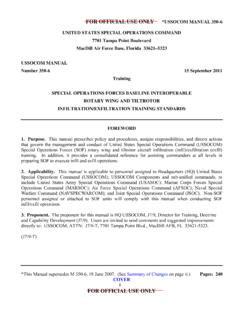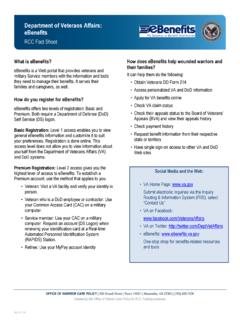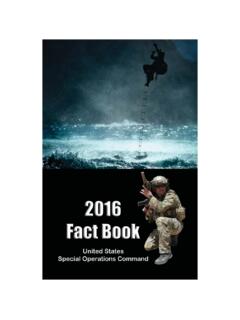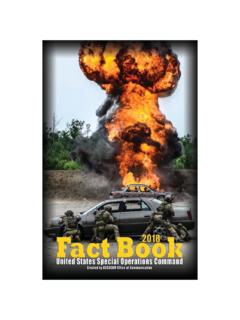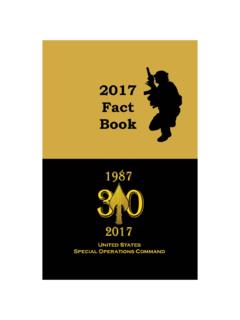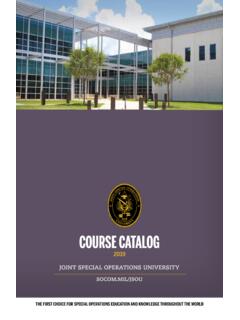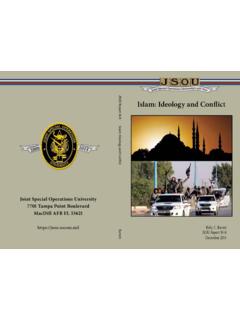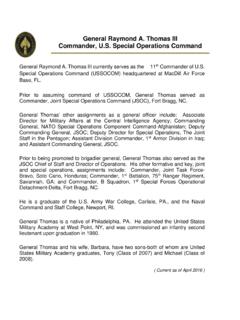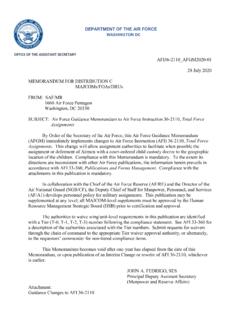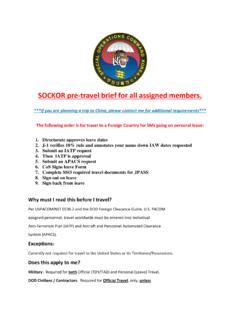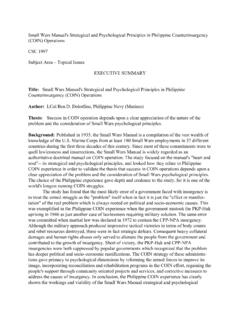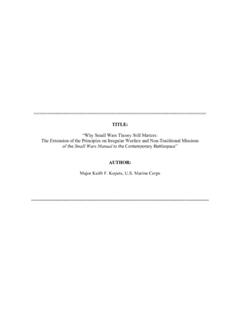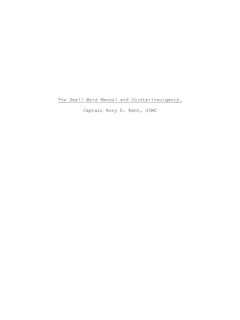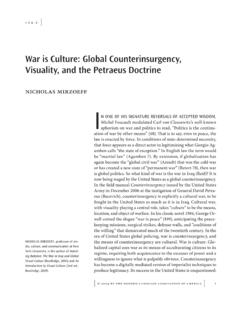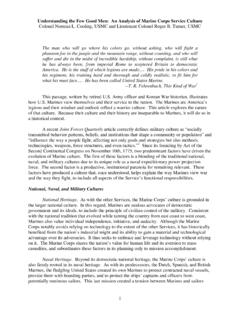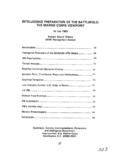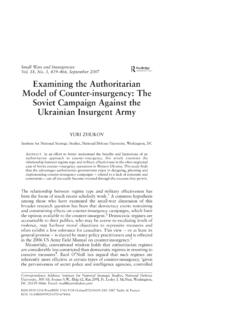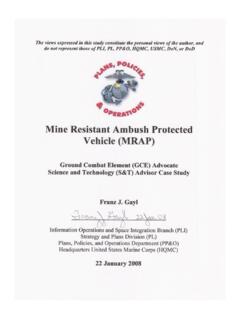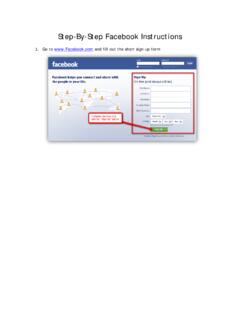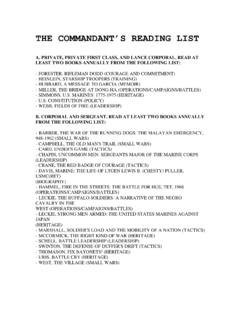Transcription of Special Operations Forces - SOCOM
1 Special Operations Forces Interagency Counterterrorism Reference ManualThe JSOU Press Hurlburt Field, Florida March 2009 Prepared by Joint Special Operations University Strategic Studies Department Hurlburt Field, Florida 32544 The Joint Special Operations University (JSOU) provides its publications to contribute to expanding the body of knowledge about joint Special Operations . JSOU publications advance the insights and recommendations of national security professionals and Special Operations Forces (SOF) students and leaders for consideration by the SOF community and defense leadership. JSOU is t he educat iona l component of t he United States Specia l Operat ions Comma nd (USSOCOM), MacDi l l Air force Base, Florida. The JSOU mission is to educate SOF execu-t ive, senior, a nd intermediate leaders a nd selected ot her nat iona l a nd internat iona l decision makers, both military and civilian, through teaching, outreach, and research in the science and art of joint Special Operations .
2 JSOU provides education to the men and women of SOF and to those who enable the SOF mission in a joint environment. JSOU conducts research through its Strategic Studies Department where effort centers upon the USSOCOM mission and the commander s priorities. The Strategic Studies Depart-ment also provides teaching and curriculum support to Professional Military Education institutions the staff colleges and war colleges. It advances SOF strategic influence by its interaction with academic, interagency, and United States military JSOU portal is Book design by Marvin Cochrane, Parks Photographic Laboratory (46 TSSQ/TSRMV) Eglin AFB, FL 32542 ISBN 1-933749-33-4 March 2009 iiiContentsPreface .. vIntroduction .. viiChapter 1. Interagency Counterterrorism Components .. 1-1 The Interagency.
3 1-2 Counterterrorism Roles, Missions, and Responsibilities .. 1-3 Functioning of the Interagency Counterterrorism Components .. 1-20 Interagency Organizations and Initiatives .. 1-26 Chapter 2. Overseas Interagency Structures .. 2-1 The Country Team .. 2-1U .S . Military Operations .. 2-5 Interagency Organizations and Initiatives .. 2-6 Chapter 3. Beyond the Interagency to Other Players .. 3-1 Intergovernmental Organizations (IGOs) .. 3-2 Nongovernmental Organizations (NGOs) .. 3-8 International Support for Afghanistan: A Case Study .. 3 -11 Chapter 4. Navigating the Interagency Environment .. 4-1 Public Diplomacy, Public Affairs, Credibility, and News Media .. 4-2 The Interagency Way Ahead .. 4-4 Appendix A. List of Organizations .. A-1 Appendix B. Ranks of Military, Foreign Service, and Civil Service Officials.
4 B-1 Appendix C. Interagency-Related Definitions .. C-1 Appendix D. USG Interagency Acronyms .. D-1 Appendix E. Bibliography .. E-1 March 2009 vForeword The SOF Interagency Counterterrorism Refer-ence manual is designed to suppor t t he Joint Specia l Operations Universit y s educationa l mission and, in particular, its series of SOF Inter-agency courses. Mr. Chuck Ricks, a JSOU Senior Fellow, compiled the volume to provide a valuable reference work for JSOU students, SOF staff officers, and partners in the interagency process. The manual provides insight and information regarding various counterterrorism players in the Government national security apparatus. While not all inclusive, this manual provides an outline of organizations, missions, and relationships that comprise the inter-agency process.
5 The interagency process is a fluid interaction involving government organizations and processes that changes the way the government is organized and adjusts its priorities to meet real-world challenges. Consequent ly, t his document is a n initia l publication that JSOU expects to update and treat as an iterative product, which will keep the document current and relevant. If you have suggestions for improvements or changes to the manual , please contact either Mr. Homer Harkins, JSOU Interagency Education Division chief, 357 Tully St., Hurlburt Field FL 32544, 850-884-5208 (or DSN 579-5208) or JSOU Press, Attn: Mr. Jim Anderson, JSOU Director of Research, 850-884-1569 (or DSN 579-1569). Michael C. McMahonLieutenant Colonel, Air ForceDirector, JSOU Strategic Studies DepartmentMarch 2009 viiIntroductionThe emergence of globally linked terror threat networks in this decade present the United States, its allies, and partners a significant a nd long-term dy na mic for v iew ing nationa l securit y.
6 The traditional concept of state-on-state military engagement will remain a valid security concern; but nonstate, v iolent, ex tremist terror net work s in a n irregular and chaotic environment means we must be agi le a nd adaptive w it h our counter strateg y. As t hese threat networks develop sophisticated operational capabi lities, t he United States must ensure its nationa l security apparatus adapts to meet these irregular, asymmetric, and nontra-ditional threats manifested in networks requires a collaborative, knowledge-based approach. Direct combat and kinetic Operations , while remaining an element in any campaign against terror and violent extremists, should not be the primary response mecha-nism or a sole basis of a national strategy to combat and counter extremists. A whole-of-government approach is required that addresses the complex and multilayered nature of these groups, the motivations driv ing t heir suppor ters, a nd t heir diverse operationa l env ironments.
7 To tr u ly reduce t his irreg u la r t hreat w i l l require a strategy to attack or mitigate the fabric and linkages bet ween terrorists, ex tremists, a nd orga nized crime operating in an increasingly interconnected global economy and assist in developing counter strategies to t hese threats, USSOCOM directed Joint Special Operations University to establish a series of SOF Interagency educational programs to facilitate collaboration and understanding across the Special Operations commu-nit y a nd ot her government depar t ments a nd agencies. The SOF Interagency Counterterrorism Reference manual is an additional element in this educational process and will be a valuable reference guide for national security professionals across the United States Government and H. HolmesBrigadier General, Air ForceExecutive Director, Interagency Task ForceMarch 2009 ixOn the cover.
8 The cover image includes a representative sample of Govern-ment department seals for those routinely involved in interagency counterter-rorism activities with Special Operations Forces . USSOCOM is one organization within the Department of Defense and among other federal agencies who work through the interagency process to achieve synchronized results. The graphic suggests networked relationships among federal agencies to highlight the concept that any one agency may be working with multiple and different partners at any point in time. The content of this manual represents an ongoing, dynamic project to capture existing interagency counterterrorism structures, organizations, responsibilities, and work flow. Changes driven by new presidential admin-istrations, fresh policy and current events inevitably alter the interagency landscape.
9 All information comes from open sources to include official fact sheets and background obtained from various official Web sites. Any omissions are completely unintentional. March 2009 1-1 Chapter 1. Interagency Counterterrorism Components Chapter 1 focuses on the USG interagency in three sections: The first section The Interagency offers a a. brief overview of the USG interagency process. While it is by no means exhaustive in its scope, the discussion provides basic information for the Special Operations warrior about both the interagency concept and its historical second section Counterterrorism Roles, b. Missions, and Responsibilities identifies the various department, organization, and agency components within the USG that address counterterrorism issues. It s important to know where specific counterterrorism expertise and resources reside, but also to understand that they frequently function separately from their parent third section Functioning of the Inter-c.
10 Agency Counterterrorism Components describes how these various components are linked together into functional work clusters centered around a lead agency responsible for carrying out specific counterterrorism activi-ties. For instance, the Director of National Intelligence is the focal point for all USG intelligence activities and coordinates the activities of the 16 members of the intelligence community and other supporting bodies that originate from throughout the SOF Interagency Counterterrorism Refer-ence manual is rooted in the understanding that no single department, agency, or orga-nization of the Government (USG) can, by itself, effectively locate and defeat terrorist networks, groups and individuals. Similarly it has become increasingly evident that it is not possible for individual countries, coalitions, intergovernmental organizations (IGOs), and nongovernmental organizations (NGOs) to go it alone against the threats of terrorists and their networks.
